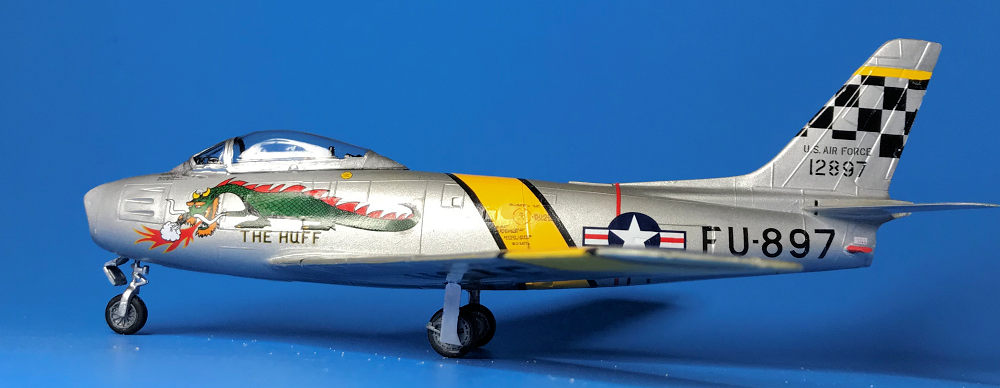
| KIT #: | 277 |
| PRICE: | $15.00 'second hand' |
| DECALS: | Two options |
| REVIEWER: | Joel Hamm |
| NOTES: | Microscale AC72-0061 decals |

| HISTORY |
Oh no, Iím not going to make a fool of myself by spouting off about a subject this well known and covered. If I have to say something in this section: It was the USís first operational swept wing fighter (which someone will likely challenge, anyway).
| THE KIT |
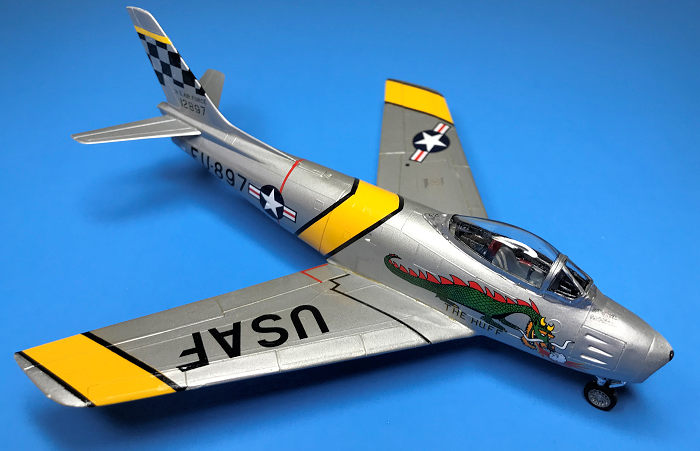 In a
previous review I mentioned that I was trying to hunt up a Heller F-86 because
Iíd heard it was a quick, easy, cheap, and foolproof build. I did and it was.
Except the last may be a function of how much a fool, or an oaf, might be its
builder. The molds date back to the previous century, but betray their age only
by mixing raised and recessed panel lines. Parts are clean and crisp; fitting
together without filling, filing, fidgeting, or fuming. Landing gear may be the
most intricately detailed of any on the market, or after-market.
In a
previous review I mentioned that I was trying to hunt up a Heller F-86 because
Iíd heard it was a quick, easy, cheap, and foolproof build. I did and it was.
Except the last may be a function of how much a fool, or an oaf, might be its
builder. The molds date back to the previous century, but betray their age only
by mixing raised and recessed panel lines. Parts are clean and crisp; fitting
together without filling, filing, fidgeting, or fuming. Landing gear may be the
most intricately detailed of any on the market, or after-market.
By current standards the canopy is a bit thick, but it is clear enough to see within the correctly shaped seat, instrument panel and side consoles, both with raised detail, and accurate control stick. (How many out there know that it is a Joyce stick, after its inventor, not a joy stick? Thereís a powerful bit of pedantry!)
| CONSTRUCTION |
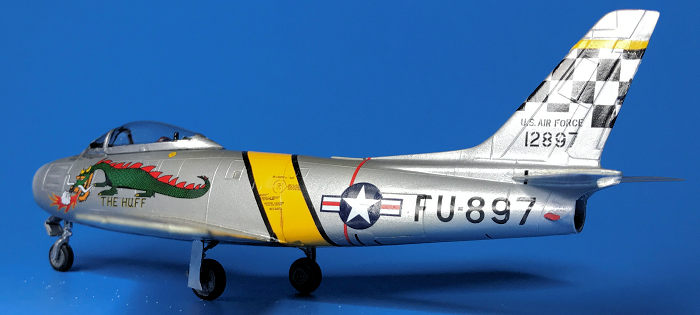 Nothing
is worth noting, except a warning that the gear and brake doors lack locating
lips to hold them level with the fuselage and wing surface if mounted closed.
One trick to keep them from sinking into their wells as the glue dries, is to
hold them in place with globs of Blue Tack, or similar gummy stuff, then flow
liquid cement into the joint.
Nothing
is worth noting, except a warning that the gear and brake doors lack locating
lips to hold them level with the fuselage and wing surface if mounted closed.
One trick to keep them from sinking into their wells as the glue dries, is to
hold them in place with globs of Blue Tack, or similar gummy stuff, then flow
liquid cement into the joint.
There are no alignment tabs to hold the horizontal stabilizers at the proper angle. I got it right on first try, but after knocking them off several times ended up with too little dihedral.
Sabres were rarely seen without aux fuel tanks, but dirtying up those sexy swept wings seemed a capital offense. This one has just returned from an encounter over the Yalu, where they had to be jettisoned.
| COLORS & MARKINGS |
This was a third and final attempt to achieve a panelized NMF with Alclad II. After stripping the resultant mess in brake fluid dosed with turpentine, I sprayed everything with a uniform coat of the only metal paint available Ė Testors square bottle aluminum. This stuff dries looking like aluminum lacquer. No problem there, since thatís precisely what most Sabres wore in actual service, particularly Herr Huff.
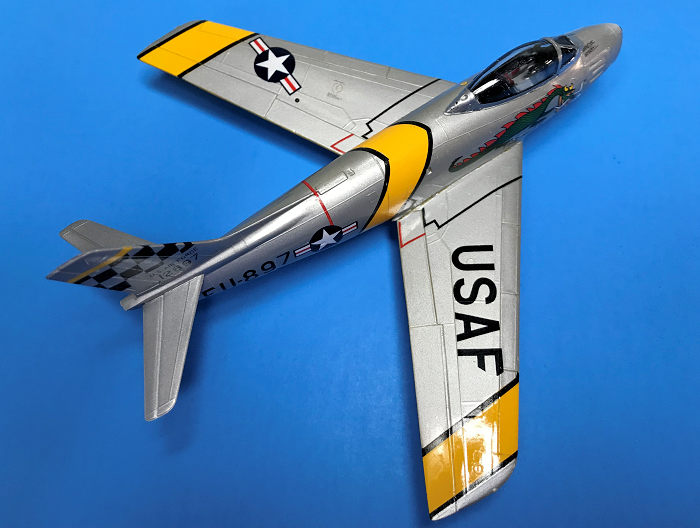 Heller sold
this kit in many boxes and markings. This one came with transfers for a German
machine, and for John Glennís Korean War mount, Mig Mad Marine. The sheet was
too far gone to save. A week of sun bleaching in a south window cured the
yellowing, but fused the decals to the backing paper. I had exhausted the spares
bin with a prior throw-away jet, and was loathe to spring twice the cost of the
kit on a new sheet. Then the Dow Jones Industrial Average topped 25K and I
figured: What am I saving it for Ė coffin stuffing?
Heller sold
this kit in many boxes and markings. This one came with transfers for a German
machine, and for John Glennís Korean War mount, Mig Mad Marine. The sheet was
too far gone to save. A week of sun bleaching in a south window cured the
yellowing, but fused the decals to the backing paper. I had exhausted the spares
bin with a prior throw-away jet, and was loathe to spring twice the cost of the
kit on a new sheet. Then the Dow Jones Industrial Average topped 25K and I
figured: What am I saving it for Ė coffin stuffing?
The only known eye-catching scheme was out of print - a plane of the Skyblazers demo team. Several were offered on line, but trusting someone elseís old sheet seemed unwise, particularly at e-Bay prices. I had to settle for a recent Microscale re-issue of the same-old-same-old: The Huff coupled with Beauteous Butch II. At least the quality was excellent. They settle down without setting fluids, but snuggle tighter with the Microscale system of Micro-set and Micro-sol; all of which was essential for laying down the black outline stripes on the yellow wing and fuselage bands (which must be painted on), and the assorted pencil line-thin whatever-they-are red line markings. A coating of Future sealed everything for the future.
| FINAL CONSTRUCTION |
Bits and pieces went on just fine. Raised details on the instrument panel and consoles got a wash (actually, gouache Ė more pedantry) of diluted black gloss, so the MS decals could be saved for later.
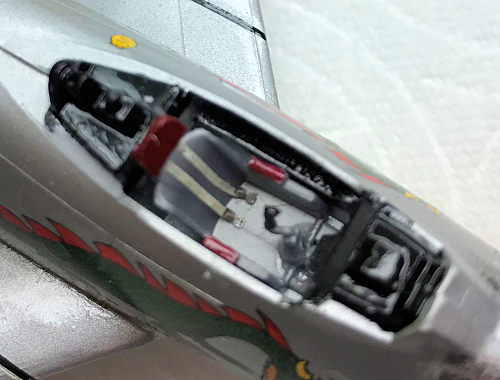 I
briefly toyed with the notion of vac-ing a thinner canopy to show off all that
stuff, but restrained myself with the reminder that this was supposed to be a
quick and simple job. Canopy framing is thick and sharp enough to do a decent
hand-brushing job, but Model Master silver chrome enamel didnít show up that
well. I tried something new: first a coat of acrylic flat black, then the metal
hue. Worked pretty well, and will become primary transparency framing technique.
I
briefly toyed with the notion of vac-ing a thinner canopy to show off all that
stuff, but restrained myself with the reminder that this was supposed to be a
quick and simple job. Canopy framing is thick and sharp enough to do a decent
hand-brushing job, but Model Master silver chrome enamel didnít show up that
well. I tried something new: first a coat of acrylic flat black, then the metal
hue. Worked pretty well, and will become primary transparency framing technique.
When I went to hand paint all the stick-ons I found the port landing gear door missing in action. Cursed a few times, searched the workbench, cursed a few more times, checked the folds of my clothes and desk chair, cursed more and scoured the carpet. Set loose Rosie Roomba, the vacuuming robot, checked her filter and dust bin. Cursed up a blue streak, then spent a whole 10 minutes shaping a snippet of flat plastic into a replacement. Later, after the project was finished, the photos taken, and the plane snug and cozy on the shelf, I discovered the missing door still attached to the sprue. Thatís why I enjoy this hobby. It has such a calming effect.
| CONCLUSIONS |
Ho hum Ė another Huff-jet. Well, at least itís not another Messy-schmidt 109.
9 February 2018
Copyright ModelingMadness.com.
If you would like your product reviewed fairly and
fairly quickly, please
contact
the editor
or see other details in the
Note to
Contributors.
Back to the Main Page
Back to the Review
Index Page
Back to the Previews Index Page